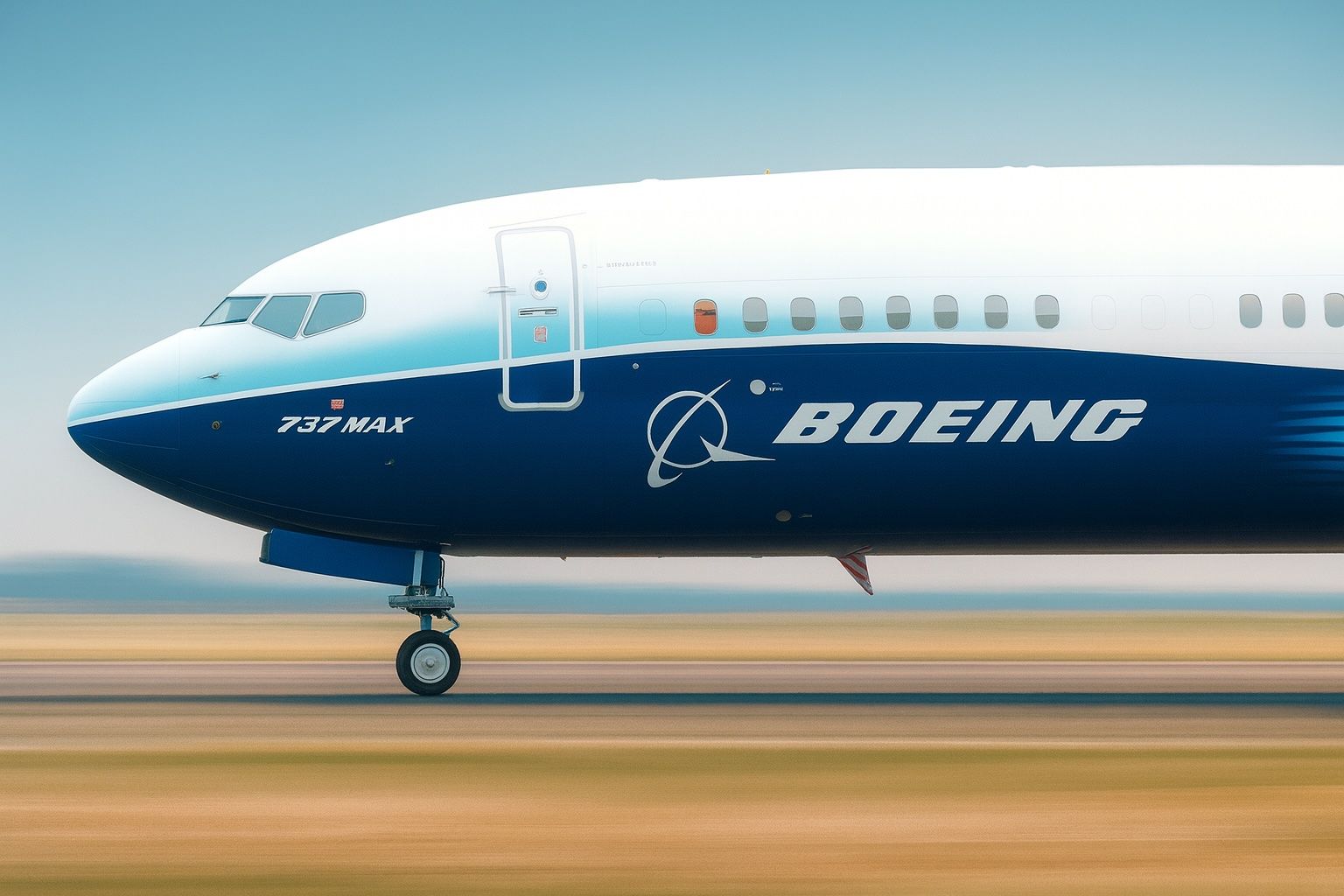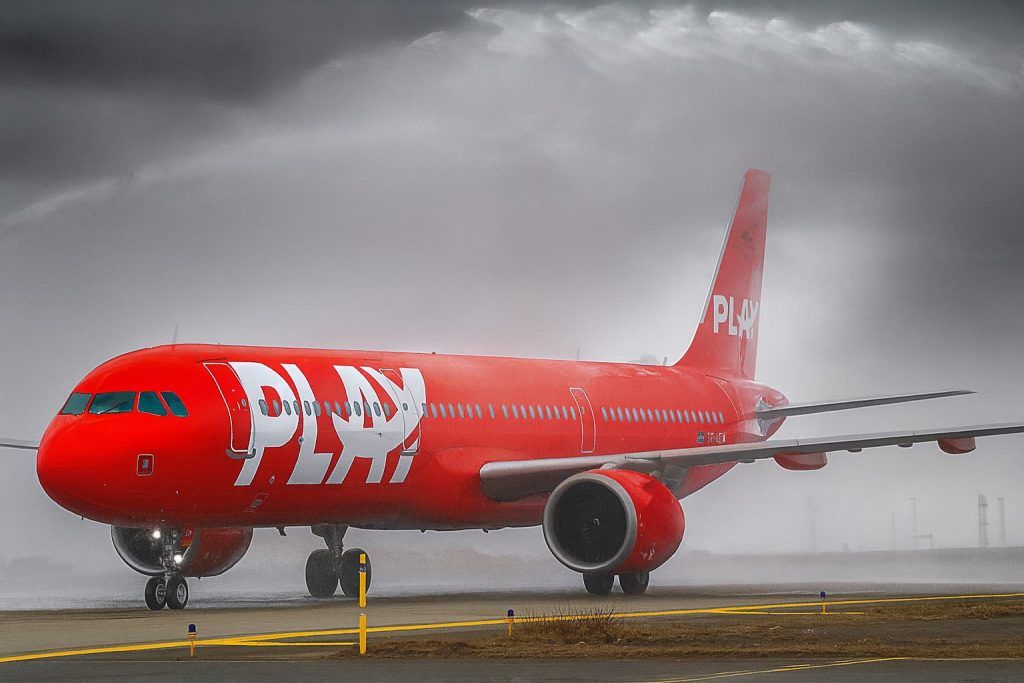- Stock price & gain: BA closed $221.26 on Sept 26, 2025, up +3.6% that day [1]. Over the past 12 months BA has surged ≈+46% (vs. S&P 500 +15%) [2]. Its market cap is about $167 B [3]. 52-week range: $128.88 – $242.69 [4]. Analysts’ consensus rating is bullish (roughly “Strong Buy”), with a 12-month target around $230–234 [5] [6].
- Major recent orders: In late Sept, Boeing announced/secured huge orders – e.g. Uzbekistan Airways committed to up to 22 787 Dreamliners (~$8.5B) [7], and Turkish Airlines placed a firm order for 75 787s (35 787-9 and 15 787-10, plus 25 options) and signaled intent for up to 150 more 737 MAX jets [8]. Separately, U.S. officials said Boeing is in talks to sell “as many as 500” new planes to China [9], a potential breakthrough in the Chinese market.
- Operational news: Boeing’s Q2 2025 results (July) showed revenue $22.75B (+35% YoY) [10]and a GAAP loss $612M (vs. $1.44B loss a year prior) [11]. Free cash flow turned positive (operating cash flow $227M vs –$3.92B prior year) [12]. The total backlog grew to $619B (≈5,900 planes) [13]. Delivery pace is rising: Boeing delivered 385 jets by Aug 2025 (vs 348 in all of 2024) [14], and production of the 737 MAX is capped at 38/mo pending FAA review.
- Labor & regulation: The IAM/AFA machinists strike at Boeing’s defense unit (St. Louis) just passed 9 weeks, but analysts note it “feels little economic pain” on Boeing [15]. Negotiations were set to resume Sep 29 with a federal mediator [16]. Regulators also made major news: on Sept 26 the FAA announced it will partially restore Boeing’s authority to issue 737 MAX/787 airworthiness certificates (alternating weeks with the FAA) starting Sept 29 [17] [18]. Boeing shares jumped ~5% on that report [19]. Other news: Boeing settled a whistleblower-linked wrongful-death lawsuit (paying ~$50K) [20], reflecting ongoing safety/legal challenges.
- Valuation & analysts: Boeing’s P/E is not meaningful (negative EPS), and many analysts emphasize cash flow and backlog instead. MarketBeat shows a consensus “Moderate Buy” and average target ≈$230 [21]. The range of price targets is wide ($140–$280 [22]), reflecting uncertainty around production and profitability. CEO Kelly Ortberg has spoken positively about tariffs boosting U.S. aerospace jobs [23]. Barclays analyst David Strauss called the late-Sep FAA news “surprising” for pushing shares higher [24], while other experts note Boeing’s cautious ramp-up of 737 output and its plan to reach 42/month pending FAA approval [25].
- Competitive landscape: Boeing’s main rival in commercial jets is Airbus. By August 2025 Airbus had delivered 434 jets vs. Boeing’s 385 [26]. Airbus CEO Guillaume Faury says Airbus is aiming to deliver ~820 jets in 2025, up 7%, but is facing engine supply delays [27]. In defense, Boeing competes with Lockheed Martin, Northrop Grumman, Raytheon, etc. For example, Lockheed’s Sikorsky unit just won an $11B Navy helicopter contract [28], and Lockheed is pushing its THAAD missile system in Europe [29]. Boeing’s defense portfolio includes fighters (F/A-18, F-15EX), tankers (KC-46), satellites, and the upcoming T-7 trainer, so it shares many government buyers with these peers.
- Geopolitical & supply-chain factors: Boeing’s business is influenced by U.S.-China trade politics (Chinese orders have been stalled, but may revive [30]), U.S. aviation policy, and global travel demand. The FAA is scrutinizing Boeing’s quality (recent inspections found hundreds of violations [31]), but the easing of FAA oversight suggests improvement. Supply-chain bottlenecks remain a concern – Boeing recently raised 787 production to 7/mo and said it will clear a backlog of delayed Dreamliner deliveries once parts arrive [32]. Meanwhile, rising defense spending (e.g. in Europe) may boost Boeing Defense, and U.S. air-traffic control upgrades (Congress approved $12.5B) could benefit industry capacity [33].
In-Depth Analysis
Current Stock Performance: Boeing’s stock (NYSE: BA) has rallied strongly over the past year. As of Sept. 26, 2025, BA closed at $221.26 [34], near its 52-week high. That day’s jump (+3.6%) far outpaced the broader market (S&P 500 ≈6676, +0.5% on the day) [35] [36]. According to one comparison, BA has “significantly outperformed” the S&P500 over 12 months (+46% vs +15%) [37]. YTD performance is driven by surging global demand for new aircraft and growing confidence in Boeing’s recovery. Trading volume (≈17M shares on Sept 26 [38]) has picked up around major news. Boeing’s market capitalization is roughly $167 billion [39]. Despite the run-up, analysts note the stock remains volatile, given Boeing’s near-term challenges. The consensus analyst rating (from ≈26 firms) is around “Moderate Buy” [40] (indeed 21 “Buy” vs 2 “Sell” recommendations [41]), with the average 12-month target ≈$230–$234 [42] [43]. This implies only modest upside, reflecting that much is already baked in.
Recent News and Announcements: In late Sept 2025 Boeing was in the news almost daily. The biggest headlinesinclude major sales and orders. On Sept 22, Reuters reported that Uzbekistan Airways plans to acquire up to 22 Boeing 787 Dreamliners – an ~$8.5 billion deal that President Trump touted as supporting ~35,000 U.S. jobs [44]. Shortly after, Boeing’s own press release on Sept 26 announced Turkish Airlines placed a firm order for 75 787s (largest-ever widebody purchase for TK) plus an intent for up to 150 more 737 MAX jets [45]. These orders will double Turkish Airlines’ Boeing fleet and were hailed by Turkish officials. Meanwhile, U.S. lawmakers visiting Beijing publicly “talked up” a possible China order of up to 500 Boeing jets – a deal reportedly near completion [46]. A Bloomberg report (cited by Reuters) had noted Boeing is indeed in talks to sell as many as 500 aircraft to China [47]. Such a breakthrough would be a huge win after years of Sino-American trade tensions.
Other operational updates included Boeing’s deliveries and production. By August 2025 Boeing had delivered 57 jets in August (best August since 2018) and 385 year-to-date, already exceeding 2024’s total [48]. This contrasts with Airbus (434 deliveries by Aug) [49]. Boeing also announced it had ramped 737 production to 38/month in Q2 2025 [50] and was increasing 787 output (Charleston line) from 5 to 7/month [51]. This was to clear a backlog: CFO Brian West said Boeing would deliver “more than a dozen” 787s that had been delayed by supply-chain problems [52].
On the labor front, talks were a mixed bag. Lockheed’s machinists union strike, which began Aug 4 at Boeing’s defense division, entered its ninth week by late Sept. Despite the disruption, analysts observed the economic impact on Boeing is relatively limited since it mainly affects lower-rate defense programs [53]. Boeing and the union agreed to resume formal negotiations on Sep 29 (with federal mediation) in an effort to end the strike [54]. Boeing has been hiring replacement workers and holding job fairs, betting it can outlast the walkout. Aviation consultancy AeroDynamic’s Richard Aboulafia noted “It’s hard to see a pain point for Boeing,” as the company tries to simply wait out the dispute [55].
A critical piece of news came from regulators on Sept 26. The FAA announced that starting Sept 29 it will once again let Boeing issue some airworthiness certificates for 737 MAX and 787 aircraft [56]. Since 2019 (after the MAX crashes) Boeing had lost this authority; it was also removed on the 787 in 2022 over quality issues. The new arrangement (FAA and Boeing alternating weeks of certificate issuance) was described as a sign the FAA believes Boeing has improved safety and quality [57]. The story (first reported by Dow Jones) sent BA stock up ~4–5% on Sept 26 [58]. The FAA press release emphasized inspectors would still oversee Boeing closely [59]. In short, this partial restoration of trust – plus steady deliveries – reassured investors that Boeing’s production problems are being addressed.
Financial Results & Valuation: Boeing has been gradually repairing its finances after years of losses. In Q2 2025 (ending June), Boeing posted revenue $22.75 billion (35% growth YoY) [60], reflecting much higher deliveries. The GAAP net loss was $612 million [61], far narrower than the $1.44 billion loss in Q2 2024. On a non-GAAP basis Boeing reported a core loss per share of $1.24 vs $2.90 prior-year [62]. Operating cash flow was +$227 million in Q2 (vs –$3.92B a year earlier), and free cash burn is on track to be modest – CFO West said Boeing expects free cash flow to turn positive by year-end [63]. The commercial-planes unit swung to a small profit ($110M op profit vs a huge loss year-ago) [64].
Key valuation metrics remain strained: Boeing’s trailing EPS is deeply negative ($–15.23 per share over 12 months [65]), so traditional P/E doesn’t apply. Forward P/E is quoted at ~800 only because analysts expect slight profits (absolute values small). Debt is still elevated (Boeing carried ~$60B in debt after the 2021/22 crises). However, rising deliveries and large backlog ($619B [66]) underpin eventual cash generation. For example, Boeing collected substantial deposits on new orders, boosting liquidity. Analysts focus more on deliveries and cash, noting that Wall Street’s models now expect break-even cash flow in late 2025.
According to published data, the consensus target for BA is in the low-$230s. StockAnalysis.com notes a 12-month target of $234 (about +6% from today) [67], while MarketBeat cites an average $230.77 [68]. Among 26 analysts tracked by MarketBeat, 21 rate BA a “Buy” and only 2 a “Sell” [69]. This consensus reflects confidence that Boeing will execute its turnaround, but also acknowledges risks. In context, Boeing’s stock already jumped ~39% from a year ago [70] and is near its peak ($242.69 52-week high [71]). Some investors view the current price as fairly valued given the remaining backlog and demand.
Expert Commentary: Boeing’s management and industry analysts have been vocal about the company’s direction. CEO Kelly Ortberg told investors in July that Boeing was seeing “more stability in our operations” after addressing past problems, and that increased deliveries marked a pivotal step in recovery [72]. He noted that tariffs implemented by President Trump have ultimately been “good for our business… and will create jobs in the U.S.” [73]. Ortberg also explained Boeing’s decision to delay certification of the 737 MAX 7/10 models (now expected in 2026) as stemming from a tricky engine anti-ice issue [74]. On production, he said Boeing plans to seek FAA permission to raise MAX output to 42 per month once quality metrics justify it [75]. Chief Financial Officer Brian West highlighted the turnaround in cash flow: he pointed out that free cash usage was only $200M in Q2 versus over $4B a year prior [76], and reassured investors that Boeing remains on track to generate positive cash by year-end [77].
From analysts, opinions vary. Barclays aerospace analyst David Strauss called Boeing’s Q2 results solid and said the share price dip was “surprising” relative to fundamentals [78]. Aviation consultant Richard Aboulafia (AeroDynamic) has noted that the current defense strike may not much dent Boeing’s earnings, saying “it’s hard to see a pain point for Boeing” given how the contracts are structured [79]. Other analysts (e.g. at JPMorgan, Goldman) have issued bullish notes on Boeing, highlighting the massive orders (like Turkey) and expectation of fewer MAX-related headaches. Industry observers stress caution too: one note cautioned that Boeing’s weight in the Dow makes any crash risk significant. But overall, recent commentary has tilted positive, pointing to a surging backlog and improved delivery rates.
Forecasts & Outlook: In the short term, Boeing is focused on ramping 737 and 787 production (within FAA’s approved caps) and managing labor disputes. With the IAM strike potentially ending soon, Boeing expects to resume KC-46 tanker and other defense deliveries smoothly. The FAA’s easing on certificates should help Boeing finalize deliveries faster. Analysts expect Boeing to gradually narrow losses and approach break-even net income by late 2025 or 2026, especially if demand holds. The company forecasts stable commercial deliveries and a return to profitability in the latter half of 2025. Street estimates (from Nasdaq/MarketBeat) for FY2025 EPS remain negative (e.g. ~–$2.30 per share annual loss), but 2026 is seen as slightly positive or breakeven. Boeing itself has not given formal guidance beyond cash-positive flow.
In the long term, Boeing’s fate ties to the global aviation cycle and defense budgets. Strong airline demand and replacement cycles for aging fleets support a bull case. Boeing’s pipeline of new jets (including future models) and services (MRO, connectivity) could drive growth. Boeing will also capture gains from infrastructure spending (e.g. satellites, space exploration). However, challenges persist: intense competition from Airbus (which is expanding in China), possible overcapacity risks, and any further safety/regulatory setbacks. Analysts’ forecasts for 2027-2030 are wide-ranging; some predict 5–10% annual revenue growth through the decade under a stable macro scenario. Boeing’s large defense backlog (e.g. Fulfill US Air Force contracts) also provides visibility. Ultimately, Boeing’s long-term outlook depends on executing production improvements and maintaining customer confidence.
Competitive Landscape: In commercial aerospace, Airbus is Boeing’s chief rival. Airbus currently leads in deliveries (434 jets by Aug vs Boeing’s 385 [80]) and has a stronger presence in the global narrowbody market (A320neo vs MAX). Airbus is fighting its own supply crunch: CEO Faury notes engine supply (Pratt & Whitney, CFM) remains the bottleneck as it strives for ~820 deliveries in 2025 [81]. Boeing competes with Airbus in selling widebodies too – e.g. the 787/Dreamliner family versus Airbus’s A330neo and A350. Boeing’s Turkish deal highlights how competitive pressures (and political ties) can swing huge orders.
On the defense side, Boeing’s Defense, Space & Security unit competes with Lockheed Martin, Northrop Grumman, Raytheon (RTX), General Dynamics, BAE Systems, and others. Each player has its niches: for example, Lockheed’s F-35 is the leading fighter globally, while Boeing’s fighters include the F/A-18 and new T-7 trainer. However, Boeing is the sole builder of the U.S. KC-46 tanker and competes with Airbus on military transport (A400M vs Boeing/KC-46). The recently announced Lockheed/RTX deals (e.g. an $11B U.S. Navy chopper contract for Sikorsky [82], and pushes of the THAAD missile system in Europe [83]) illustrate that budgets flow across these companies. Analysts often compare Boeing to Lockheed: some note Boeing’s stronger commercial exposure versus Lockheed’s government focus. Boeing also faces emerging competition in launch and satellite (SpaceX, etc.), but those are smaller segments for now.
Regulatory, Geopolitical, and Supply-Chain Factors: Boeing’s prospects are tightly linked to government policy and global events. The FAA’s ramp-up decisions (e.g. potential production-rate increases once quality is verified [84]) will shape how quickly Boeing can capitalize on strong orders. Environmental regulations are also looming: both airlines and OEMs (including Boeing) prepare for sustainable aviation fuel mandates and emissions standards. Trade policy matters greatly – the U.S.-China relationship has been a key driver of Boeing’s business. The recent thaw, including high-level talks and possible large sales to China [85], could unlock significant revenue; conversely, any new tariffs or export restrictions (as were briefly applied to China earlier in 2025) could hurt. Similarly, defense exports depend on geopolitical alliances (e.g. Turkey’s potential F-16/F-35 purchases or delay, NATO demand for C-17/KC-46, etc.). Recent U.S. policy (like restoring Boeing’s ODA privileges [86]) suggests regulators are gradually returning trust.
Supply-chain constraints remain a practical hurdle. Boeing’s deliveries have been delayed by parts shortages (e.g. wiring harnesses, composites, engines). The company and its supplier Pratt & Whitney (RTX) have struggled with engine coating issues affecting both Boeing and Airbus aircraft [87]. Boeing, though, has been clearing its backlog: it said a 7-jet monthly 787 output would whittle down delayed units this year [88]. The company is also dealing with fallout from the Jan 2024 Alaska Airlines blowout – the FAA imposed a production cap (38/mo) as a precaution [89]. Boeing is under an ongoing Deferred Prosecution Agreement with the DOJ, so compliance will factor into its decisions and costs.
Sources: Authoritative data and news were drawn from Boeing’s investor releases and major media. Key references include Boeing’s Q2 2025 results [90] [91], Reuters and FAA press statements on recent developments [92] [93] [94], and market data sites for stock performance [95] [96]. Analyst ratings and forecasts are from finance aggregators [97] [98]. All specific figures and quotes above are cited to the corresponding sources.
References
1. www.investing.com, 2. www.alphaspread.com, 3. stockanalysis.com, 4. www.investing.com, 5. stockanalysis.com, 6. www.marketbeat.com, 7. www.reuters.com, 8. investors.boeing.com, 9. www.reuters.com, 10. investors.boeing.com, 11. investors.boeing.com, 12. investors.boeing.com, 13. investors.boeing.com, 14. www.reuters.com, 15. www.reuters.com, 16. www.reuters.com, 17. www.reuters.com, 18. www.reuters.com, 19. www.reuters.com, 20. www.reuters.com, 21. www.marketbeat.com, 22. www.marketbeat.com, 23. www.reuters.com, 24. www.reuters.com, 25. www.reuters.com, 26. www.reuters.com, 27. www.reuters.com, 28. www.reuters.com, 29. www.reuters.com, 30. www.reuters.com, 31. www.reuters.com, 32. www.reuters.com, 33. www.reuters.com, 34. www.investing.com, 35. www.investing.com, 36. www.investing.com, 37. www.alphaspread.com, 38. www.investing.com, 39. stockanalysis.com, 40. www.marketbeat.com, 41. www.marketbeat.com, 42. stockanalysis.com, 43. www.marketbeat.com, 44. www.reuters.com, 45. investors.boeing.com, 46. www.reuters.com, 47. www.reuters.com, 48. www.reuters.com, 49. www.reuters.com, 50. investors.boeing.com, 51. www.reuters.com, 52. www.reuters.com, 53. www.reuters.com, 54. www.reuters.com, 55. www.reuters.com, 56. www.reuters.com, 57. www.reuters.com, 58. www.reuters.com, 59. www.faa.gov, 60. investors.boeing.com, 61. investors.boeing.com, 62. investors.boeing.com, 63. www.reuters.com, 64. www.reuters.com, 65. stockanalysis.com, 66. investors.boeing.com, 67. stockanalysis.com, 68. www.marketbeat.com, 69. www.marketbeat.com, 70. www.reuters.com, 71. www.investing.com, 72. www.reuters.com, 73. www.reuters.com, 74. www.reuters.com, 75. www.reuters.com, 76. www.reuters.com, 77. www.reuters.com, 78. www.reuters.com, 79. www.reuters.com, 80. www.reuters.com, 81. www.reuters.com, 82. www.reuters.com, 83. www.reuters.com, 84. www.reuters.com, 85. www.reuters.com, 86. www.faa.gov, 87. www.reuters.com, 88. www.reuters.com, 89. www.reuters.com, 90. investors.boeing.com, 91. investors.boeing.com, 92. www.reuters.com, 93. www.faa.gov, 94. www.reuters.com, 95. www.investing.com, 96. www.alphaspread.com, 97. stockanalysis.com, 98. www.marketbeat.com







